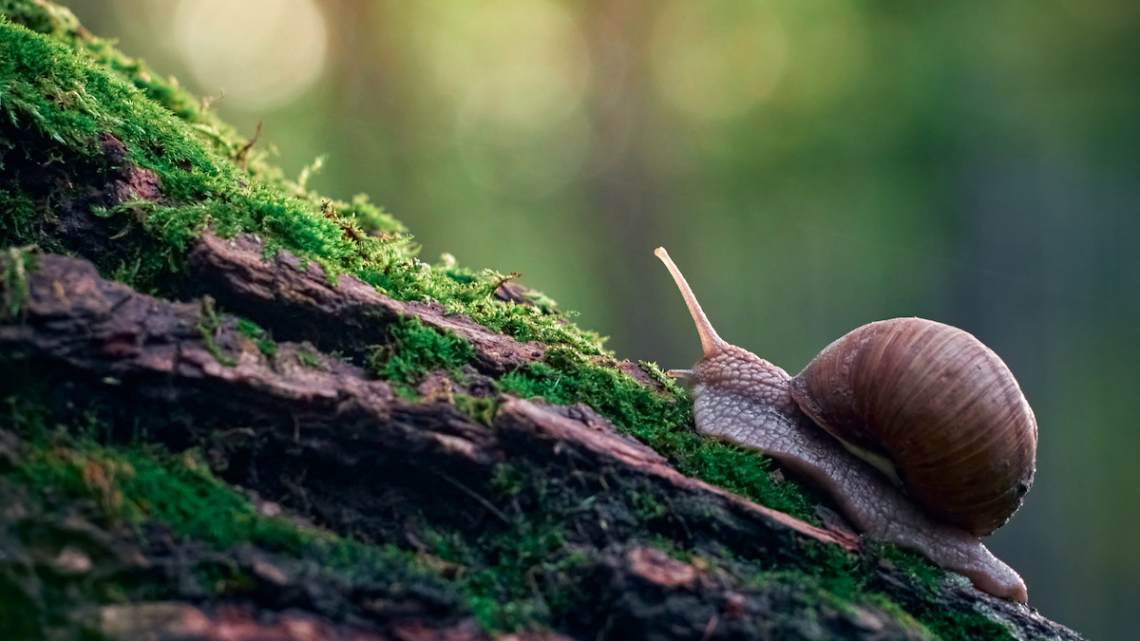Did you know there are more than 40,000 species of snails on the planet? Or that they thrive in salt water, fresh water, and on land? Some grow huge, like the Syrinx aruanus, weighing up to 40 pounds and sporting a shell 35 inches long! And others prove tiny enough to slip through a sewing needle’s eye.
As invertebrates, snails don’t have spines. Instead, they tuck their slimy mucus bodies into the makeshift shell homes they carry on their backs. But perhaps the craziest fact about snails is that the garden variety boasts more than 14,000 teeth on their radulae. (Think the snail equivalent of tongues.)
Of course, plenty of stereotypes surround snails, including the notion they’re slow-moving and don’t do much. But what if we told you they race, conquer, and can even be venomous? And that’s just for starters!
Snails That Race
During the COVID-19 pandemic, lots of stuff got put on hold. From schooling to weddings, doctor’s appointments to movie showings. And in the pastoral hamlet of Congham, England, the Snail Racing World Championships came to a halt, too. Fast forward three years, however, and the slowest animal race in the world is back on track.
Founded in the 1960s by Tom Elwes, the Englishman took inspiration from snail racing events in France. Fortunately, England’s racing participants don’t face the looming threat of becoming escargot. Held at Grimston Cricket Club, the race involves traveling 13 inches as quickly as possible. In 1995, a shelled fellow named Archie set the world record of 22 seconds. It remains unshattered today.
But other records are still ripe for the making. These include the distinction of being the oldest humane snail-racing championship on the planet. Congham secured this title with the 2023 return of the event. What does the top snail win? A tankard of lettuce guaranteed to keep those 14,000+ teeth busy!
Snails That Conquer (by Accident)
Considering how slowly snails move, the thought of them conquering land areas sounds downright ridiculous. Don’t tell that to Florida’s giant African land snails (GALS), though. This invasive species has returned to the “Sunshine State,” where it’s doing a number on the environment and local agriculture.
According to the Florida Department of Agriculture and Consumer Services, “The giant African land snail is one of the most damaging snails in the world, consuming at least 500 different types of plants.” GALS attach themselves to the siding of houses, eating paint and stucco walls. And they inadvertently spread diseases like rat lungworm, which causes meningitis in humans.
Stopping them isn’t easy due to their high fertility rates. The brown-shelled mollusks contain both male and female sexual organs. They can reproduce by the thousands (without a partner) after reaching sexual maturity at four months old.
Luckily, they grow to eight inches long and five inches in diameter, making them a cinch to spot and remove as adults. Of course, Florida’s conquering snails aren’t on a power-hungry quest to rule the world.
According to the University of Florida, they entered the state in 1966 when a child smuggled three in from Hawaii. How did the East African natives get to Hawaii before that? Again, it involved people.
Folks transported GALS to the Hawaiian Islands in 1936 to serve as pets and for educational purposes. So, while it’s important for Florida to counteract the spread of this invasive species, you can’t blame GALS for doing what comes naturally — eating, reproducing, and slithering.
Snails That Kill (and Cure)
Yes, you read that last heading right. Some snails can be dangerous, and we don’t mean indirectly through disease. Cone snails have some of the loveliest shells in the mollusk world, but certain species contain venom capable of dropping humans. Even more shocking is their poison delivery system. A lightning-fast harpoon-like structure that spears prey and potential threats, including people. Don’t believe us? Check it out for yourself!
Fortunately, only about 100 people have died by cone snail. (You can go back to worrying about more likely scenarios, like lightning or shark attacks.) But scientists are now using their venom molecules to pioneer potential leads for new drugs and medicines.
It all started when researchers successfully raised the deadly mollusk in a laboratory aquarium for the first time. In the process, they shed new light on these elusive creatures and their unique life cycle
Richard Lewis of the University of Queensland explains, “A lot of our success with venom molecules has been in developing pain medications, but depending on the pharmacology, we’ll see if it has therapeutic potential for any of the disease classes.” Put another way, studying deadly cone snails shows great medical promise for the future.
By Engrid Barnett, contributor for Ripleys.com









